Magmatic action still underway at Lassen Volcanic Park
October 21, 2015
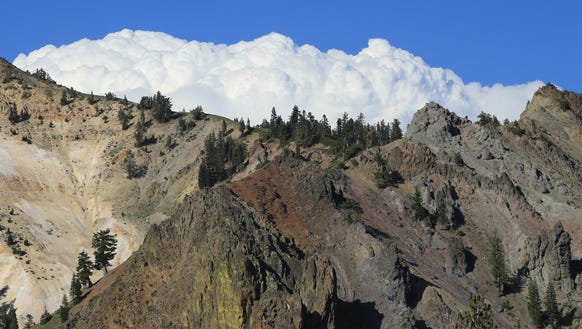
Clouds gather over the peaks of Lassen Volcanic National Park in northern California. (Photo: Brian Passey / The Spectrum & Daily News)
Some of my favorite national park experiences have been at the lesser-known parks.
Last year I discovered — and fell in love with — Homestead National Monument of America. This year's discovery is Lassen Volcanic National Park.
Lassen was a late addition to my honeymoon plans. It was along one possible route to the northern California redwoods and my wife, Cammie, and I figured adding another national park to the itinerary couldn't hurt.
It's early August and we're on the second day of our honeymoon as we approach the park from the south. Initially it looks similar to much of northern California — a mountainous area covered in evergreens. But geologists will note something interesting about this particular park: Every rock is volcanic in origin.
One of the first peaks we see is Brokeoff Mountain. A 3.5-mile trail to the top of the extinct volcano offers views of lakes and other prominent features, like Lassen Peak, a still-active volcano that rises above the park at 10,457 feet. Brokeoff Mountain is the remnant of the former Mount Tehama — also called Brokeoff Volcano — a stratovolcano whose activity decreased about 400,000 years ago.
However, volcanic activity continues at Lassen and feeds a variety of hot water systems throughout the park. As we drive into what was once the center of Mount Tehama we arrive at the Sulphur Works, an almost-alien landscape of yellow where mudpots boil and shoot hot, gray mud into the air.
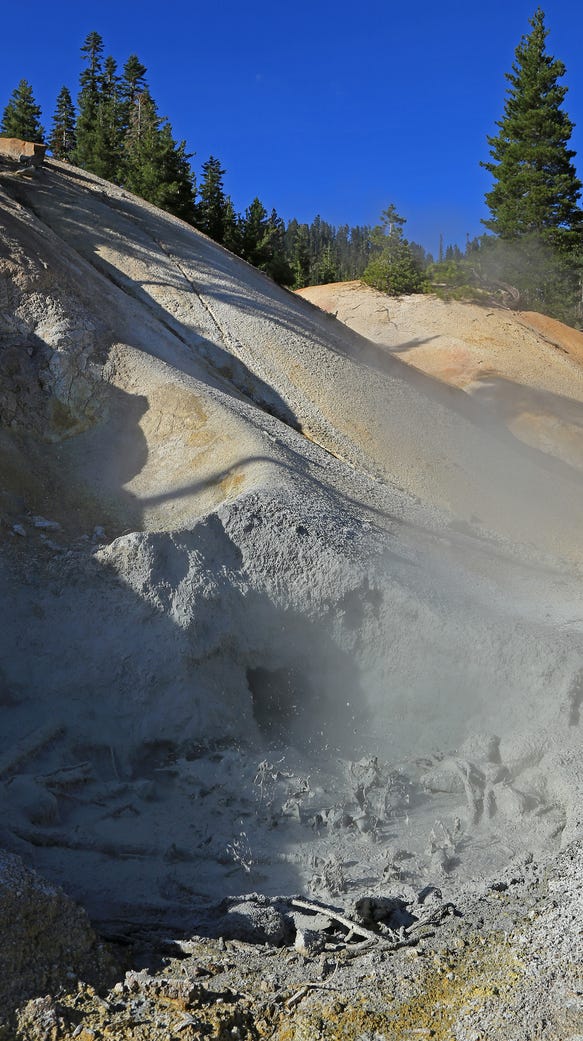
A mudpot bubbles at the Sulphur Works in Lassen Volcanic National Park. (Photo: Brian Passey / The Spectrum & Daily News)
Despite the stench you might expect, given its name, we stop at the Sulphur Works for a little walk. Fences keep visitors away from the mudpots, boiling springs and fumaroles (steaming vents) but you can still get close enough to come away with mud spots.
A sign tells us that far below in the earth is a network of partially molten rock that creates a magmatic system, which in turn heats the groundwater to a boil. This hydrothermal system is what remains of the magmatic system that once fed the mighty Brokeoff Volcano.
Before the Sulphur Works was included in the national park, a privately owned resort stood here and offered lodging, dining and a bathhouse built over the steam vents. Before it became the Sulphur Works Inn, it was a mine where the innkeepers' ancestor, Mathias Supan, mined sulphur to sell as "mine medicine" products at a drugstore in Red Bluff.
After we get our fill of boiling ground and the smell of rotten eggs, we continue along the highway as it winds around through the caldera of the extinct stratovolcano. Unfortunately the impressive panoramic views are a little hazy because of wildfires burning to the west.
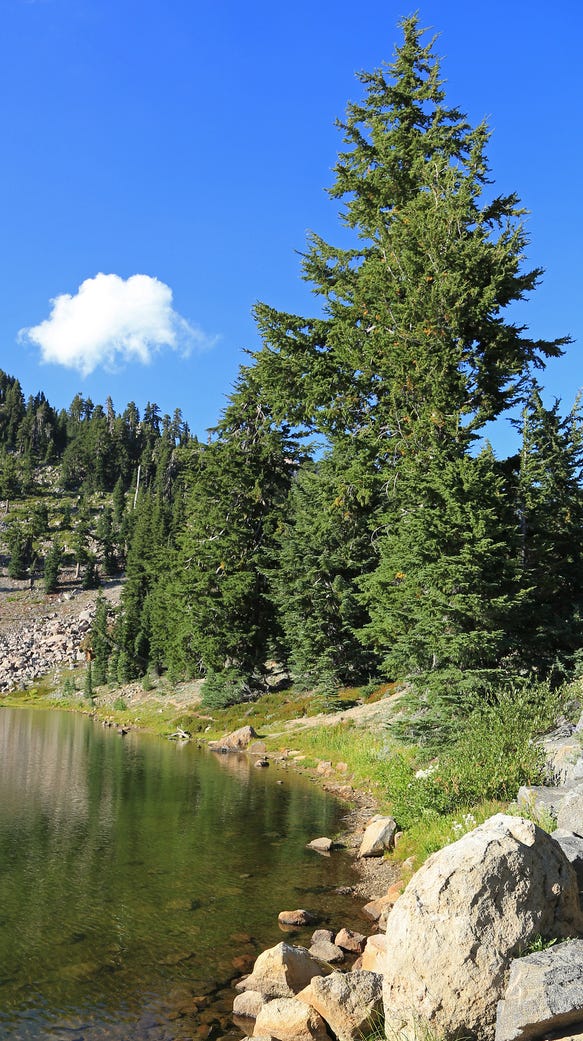
Trees reflect in Emerald Lake at Lassen Volcanic National Park in northern California. (Photo: Brian Passey / The Spectrum & Daily News)
Close-up scenery, however, is still quite clear and pretty, like Emerald Lake, which sits alongside the highway just northeast of the Sulphur Works. This shallow, glacial lake gets its name from the color created by algae that grows on its lake bottom. It's also home to Cascade frogs, a species of special concern in California.
As the lake suggests, volcanoes were not the only natural forces at work in shaping this park. Beyond Emerald Lake is an overlook with views of glacial erratics — boulders deposited by glaciers as they worked their way over the surrounding slopes. The erratics are located near the trailhead for Bumpass Hell (yes, that's it's actual name), one of the largest hydrothermal areas in the park, reachable by a 1.5-mile trail.
Three other hydrothermal areas — Devils Kitchen, Boiling Springs Lake and Terminal Geyser — can all be accesses in the Warner Valley area east of Bumpass Hell via a different park entrance.
It's late in the day so we don't have time to hike into Bumpass Hell. But we already know we want to return to Lassen with more time to kill. Instead we continue on, along the highway to the next body of water: Lake Helen. This deep blue lake provides a great foreground to the majestic gray hulk that is Lassen Peak, which saw its last major eruption in 1915 but remains active.
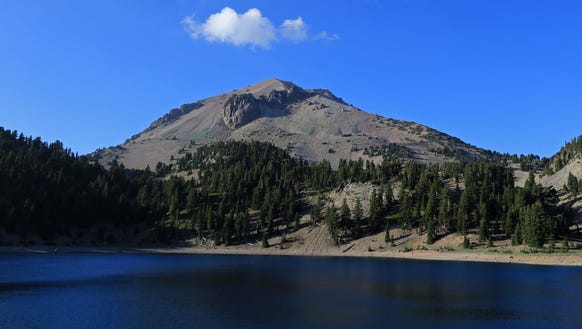
Lassen Peak towers over Lake Helen in Lassen Volcanic National Park. (Photo: Brian Passey / The Spectrum & Daily News)
After Lake Helen we simply enjoy the beauty of the park as we drive along the highway, which was originally constructed in 1925, nine years after Lassen became a national park. The area was first protected in 1907 with a pair of national monuments.
While we don't see much hydrothermal activity along this section of the route, the landscape remains quite beautiful with its mix of sweeping vistas, deep forests and verdant meadows.
Eventually we make it to the park's west entrance and stop for a break at the Loomis Museum. Although the museum is already closed for the day, we take a nice relaxing walk around the trees and even spot a few deer in the forest.
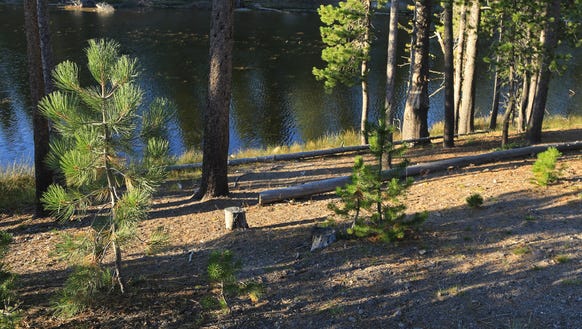
Reflection Lake is tucked among the trees at Lassen Volcanic National Park in northern California. (Photo: Brian Passey / The Spectrum & Daily News)
As we leave the park, the setting sun is reflecting off the appropriately named Reflection Lake and nearby Manzanita Lake — two more features I'm eager to explore a little more when we make our return to Lassen. A couple of hours is not nearly enough time to see the park but it's still a gorgeous drive.
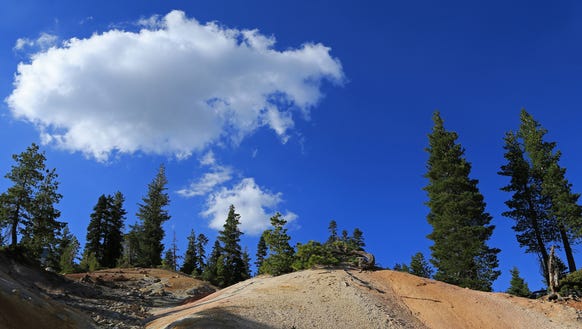
The Sulphur Works at Lassen Volcanic National Park add color to the mountainous landscape. (Photo: Brian Passey / The Spectrum & Daily News)
--
__._,_.___

No comments:
Post a Comment